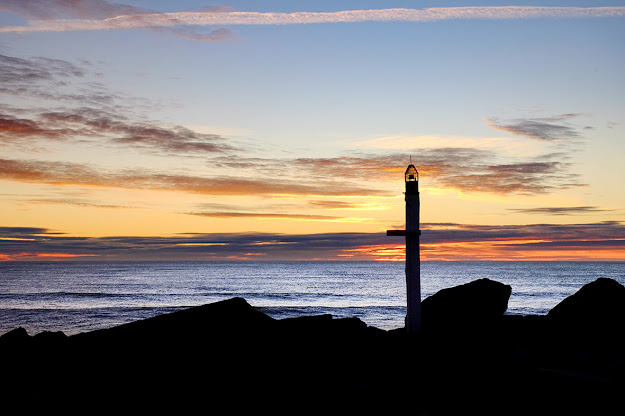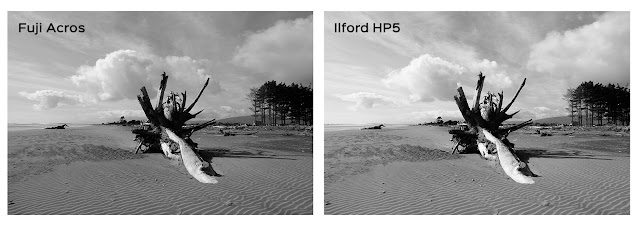Jpeg-only week two with Kodak E100SW film simulation
I'm in to my second week of shooting on Jpeg-only using film simulations SOOC (straight out of camera), and so far, so good. This week it was the turn of the film simulation that I have programmed into the prime slot (C1) on my Fujifilm X-E2. What's the recipe that deserves this prime location? None other than Kodak Ektachrome E100SW.
To be honest, it's not a film stock I've actually shot a lot of, since processing slide film here in New Zealand is a costly business. I've basically chosen it because I liked the look of the images that accompanied this recipe on Richie Roesch's Fuji X Weekly site.
 |
| Tiphead Sunset, Cobden. f/8 @ 1/250th, ISO 400. Ektachrome E100SW film simulation |
For my 'main' recipe, I wanted something that had some vibrancy, but not as intense as the Velvia recipe. On Kodak's own technical data sheet it describes E100SW as "producing warm, saturated colors (the SW stands for saturated warm)". They also claim it is "well suited for location photography... excellent for photographers who prefer a warm scene rendition". It features Kodak's T-Grain emulsion for extremely fine grain and very high sharpness, producing "exceptional results in editorial, sports, travel, advertising, and corporate/industrial applications". Sounds great. But what's the recipe actually like out of the X-Trans II sensor on the X-E2?
 |
| Blaketown Tiphead Sunset. f/8 @ 1/60th, ISO 800 |
The results look pretty good to me. Saturated - especially in the warmer colours - without being too over the top. The images posted here are fairly representative of what I was seeing with my own eyes. I've actually boosted the saturation a little in post (LR). I'm finding that, within reason, the Jpegs can take a decent amount of post processing. If anything I'm tending to under-expose perhaps a little more than I would normally - just to preserve those highlights. I don't mind a deep, rich black in the shadows - especially in an image like the first one in this post where I'm intentionally going for a silhouette. What I really want to avoid at all cost, especially with a jpeg, is blown out highlights!
 |
| Looking towards Blaketown. f/8 @ 1/60th, ISO 1600 |
So what does my Kodak Ektachrome E100SW film simulation recipe for the X-Trans II sensor consist of? Once again, credit where credit is due, it's a 'tweaked' version of Richie's found on his Fuji X Weekly site. My Ektachrome E100SW recipe is:
Kodak Ektachrome E100SW
Film Stock: Velvia
DR:200
Colour: -1
Sharpness: +1
Highlight tone: +1
Shadow Tone: +1
Noise Reduction: -2
White Balance: Auto (+1R, -1B)
ISO: Auto up to 3200
As you can see, it uses the Velvia stock film simulation, but dials the colour back to -1. So, as mentioned above - punchy colours, but not as punchy as my Velvia recipe (which uses +2 colour). Highlights and Shadows are both boosted slightly, as is sharpness. This produces the 'super sharp, super fine-grain' quality that E100SW is known for. And finally, a very subtle +1 in the red channel and -1 in the blue channel shifts the white balance to an ever so slightly warmer colour rendition. And there you have it - Ektachrome E100SW.
 |
| Cobden surf club tree silhouette. f/8 @ 1/70th, ISO 400 |
I've said it before, and I'll say it again with all these film 'simulations': - is it exactly like Kodak Ektachrome E100SW? Well, no - of course it's not. Film is, well, film. But does it produce the kind of colours and visual effect I'm looking for when I 'think' of E100SW as a film stock? Well yes... yes it does. And that's all where trying to do here. At least that's all I'm trying to do here. So that when I go out shooting with my X-E2, and I want colourful, sharp, yet natural results from my jpegs, then this is the film simulation I'm going to choose. In my head I'll be thinking E100SW. But in reality I'll be shooting with a digital camera. Duh!
 |
| Cobden Beach waves. f/8 @ 1/60th. ISO 2500 |
I'm very, very happy with the Jpegs that I'm getting so far with the two film simulations I've programmed into the X-E2. I've been shooting under some fairly tricky lighting conditions - mostly late evening - handheld, and getting some superb results - even at fairly high ISO's. As I said in my Velvia review, these are all just test shots taken with the intention of posting on the web. If I was out on a 'serious' landscape shoot I would be using a tripod and setting the lowest ISO I could.
Even so, the quality of these 'snapshots' is excellent, and they have handled a modest amount of post processing in Lightroom and Photoshop. Maybe in a future post I'll do a SOOC vs post-processed result, just to show how much a modern Jpeg can be edited?
But for now, I can say that I'm happy with these results using the Ekatachrome 100SW film recipe. It seems to justify its position at the head of the pack, as custom film simulation C1 in my Fuji X-E2.



Comments
Post a Comment